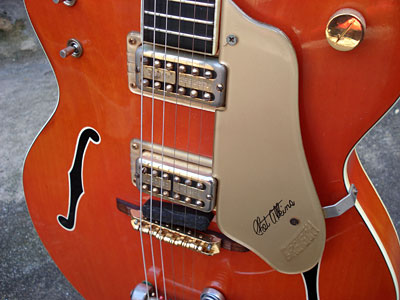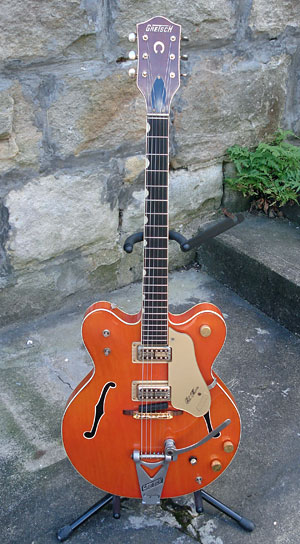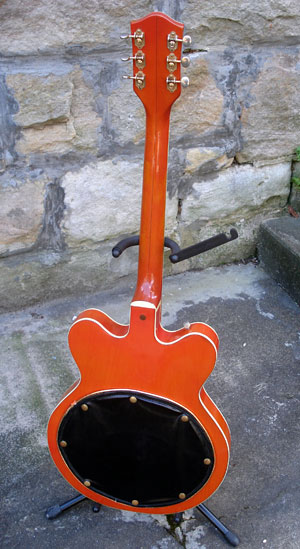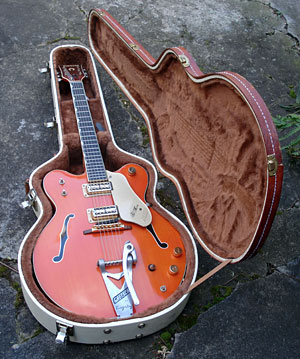1964 Gretsch Chet Atkins 6120
I bought this guitar from California in May 2008 because I was pining for the 1962 one that I bought and sold in 1990. This guitar was nothing but bad luck for me. When I bought it on ebay it took 5 weeks between paying for it and receiving it, involving major dramas with a dodgy seller 10,000 miles away. NEVER buy on ebay from anyone who is "selling it for a friend". Then when I sold it through a shop in Sydney in 2012 it took 7 months to get my money! NEVER sell anything on commission if you can possibly help it.
It was in fantastic condition for its age, it has almost no dings, the back of the neck was unblemished, and the binding rot that is all too common on old Gretsch guitars was pretty minimal. When I got it, it was all original apart from the bridge and the gold plated knobs that are shown in these photos. Since then I managed to get hold of some early '60s knobs, but the bridge is actually an improvement so I did not replace it. The intonation was excellent. It had the original white case, with tooled brown leather trimming (photo at right bottom), and even had a vintage flyer in the case touting the virtues of the pickups.
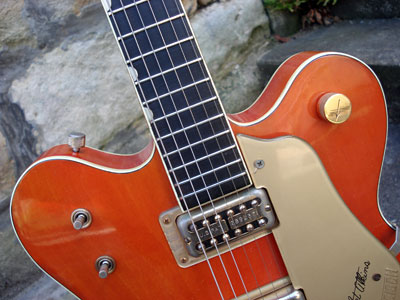
These guitars had some pretty quirky 'innovations':
- The tone switch (known as "mud switch") is best removed and thrown away, which is apparently what Brian Setzer does to his Gretsches. That's the one closest to the f-hole on the upper bout.
- The padded back is not too comfortable and is really just a way of covering up the back plate that allows access to the inside of the body.
- Then there's the mute - what the hell were they thinking? A high percentage of these guitars that come up for sale have had this system removed. This is actually an improvement, but will most likely reduce the value of the guitar because it's not "original". That's the vintage guitar market for you.
- The body is hollow, and the f-holes are actually painted on the body to keep the look of a semi acoustic without the feedback problems.
- Thumbprint position markers - as far as I know, no one else has ever done this and I think they look great.
- There's also a "standby switch" so you can turn the guitar off during breaks.
Despite the dodgy "features" the sound is fantastic - I love the crunch of the Filtertron pickups combined with the hollow body. It's best with heavier gauge strings on it, but I found that light top heavy bottoms (10-52) work really well. The Bigsby tremolos work great as long as you use them lightly and of course they will vary from one guitar to another.
This model was introduced in late 1961 (before that the 6120 model was a thicker hollow body with real F holes, as played by Brian Setzer). In late 1964 it was renamed "Nashville" and the horsheshoe inlay on the peghead was replaced by a metal plaque, and apparently a pebble grain vinyl backpad. My one must be an early '64 model.
In 1971 this model was renamed "7660", in 1973 it went back to having open F holes, and was discontinued in 1980. Since then they have started making Japanese ones, and those are most likely at least as good as the originals from the '60s.
As of October 2012 I have replaced this one with a Japanese made 6121 Roundup, which is easily as good as this one.
More Info
- The Gretsch Pages
- Gretsch specifications
- Great story about Pete Townshend's Gretsch
- Interesting article about Filter'Tron pickup history
